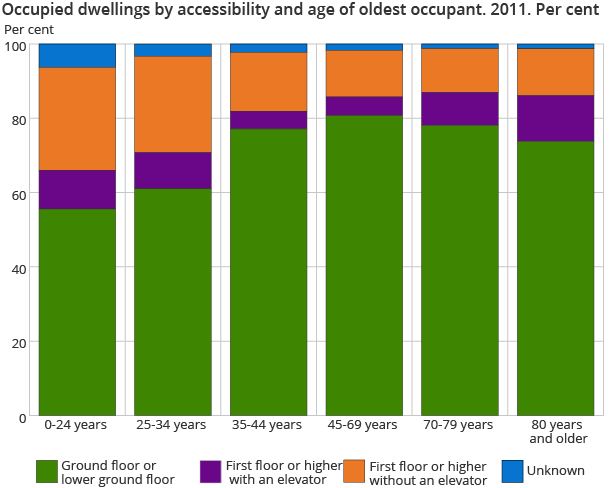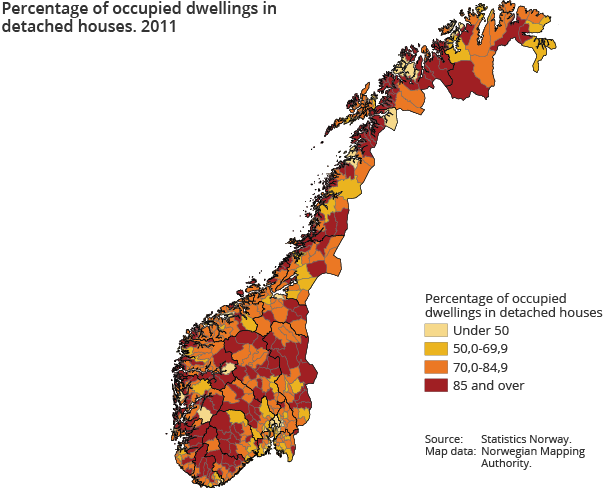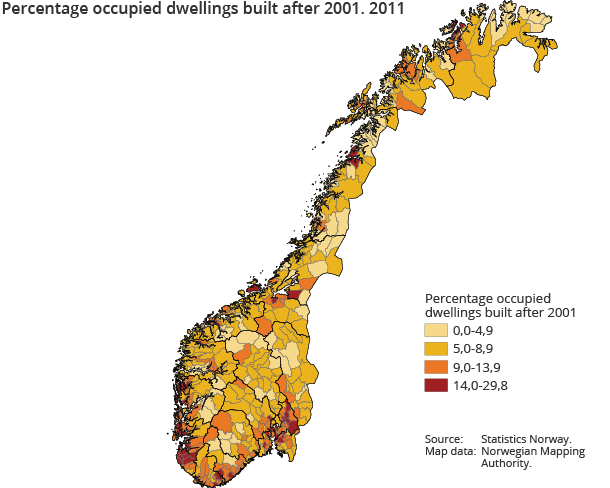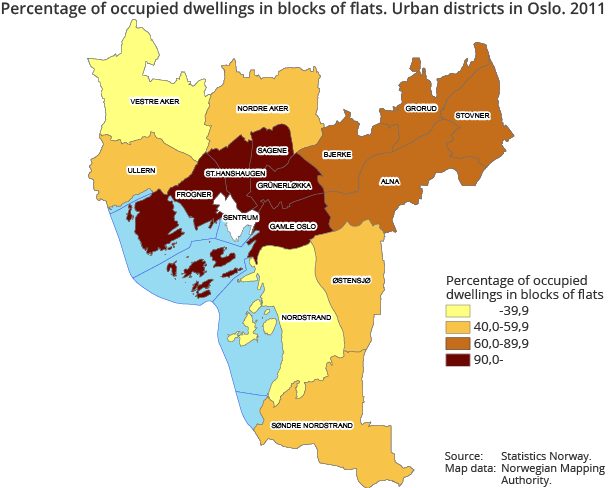Content
Published:
One in six living in block of flats
According to the 2011 population and housing census there were 2 205 000 occupied dwellings in Norway on census day, 19 November. A total of 23 per cent were block apartments, meaning that 17 per cent of all inhabitants lived in a block of flats. Sixty per cent lived in a detached house.
| Occupied dwellings | Occupants | Occupants per dwelling | |||
|---|---|---|---|---|---|
| Numbers | Per cent | Numbers | Per cent | ||
| 181 418 persons in institutional households or with housing arrangements unknown not included. | |||||
| Total | 2 205 191 | 100.0 | 4 898 537 | 100.0 | 2.2 |
| Detached house | 1 166 721 | 52.9 | 2 948 583 | 60.2 | 2.5 |
| House with 2 dwellings | 201 865 | 9.2 | 471 616 | 9.6 | 2.3 |
| Row house, linked house and house with 3 dwellings or more | 260 860 | 11.8 | 554 293 | 11.3 | 2.1 |
| Multi-dwelling building | 500 938 | 22.7 | 818 823 | 16.7 | 1.6 |
| Residence for communities and other building | 74 807 | 3.4 | 105 222 | 2.1 | 1.4 |
This is the first Norwegian housing census to be based solely on register data. This means that no information has been collected directly from the households using questionnaires. The change in data collection method may have impacted the comparability with the 2001 census
Detached houses most common in the majority of municipalities
In four out of ten municipalities more than 85 per cent of all dwellings were in detached houses. Most of these municipalities are rural. Oslo had by far the lowest portion of dwellings in detached houses; less than 10 per cent, but also in Bergen and Trondheim the percentage was below 30. Most municipalities with a low portion of dwellings in detached houses were cities and their neighbouring municipalities. These types of municipalities also have the highest portion of dwellings in houses with two dwellings, row houses and other small houses.
Three out of five in Oslo lived in a block of flats
In Oslo, as much as 72 per cent of all dwellings were block apartments, meaning that 62 per cent of all residents in the capital lived in a block of flats. However, there were large differences between urban districts. In the inner city, between 85 and 95 per cent lived in a block of flats, while in the suburban districts of Oslo this was much less common. Bergen had the second largest portion of dwellings in blocks of flats, with 42 per cent. Also in Bergen the percentage was largest in the more central urban districts.
The number of dwellings in blocks of flats increased by 30 per cent from 2001 to 2011, while the number of dwellings in detached houses increased by only 4 per cent in this period. The percentage of block apartments increased most in the counties of Akershus, Rogaland and Sør-Trøndelag. The increase in Oslo was below the national average.
Living in a block of flats most common among young people and the elderly
The percentage living in a block of flats was highest among persons aged 20-39 years and persons 80 years and older. More than 20 per cent in these age groups lived in block apartments. The percentage living in detached houses was highest for persons aged 40-69 years and persons below 20 years. Type of dwelling is related to size of household. Small households are most common among young adults and the elderly.
Many new dwellings in suburban areas
Of the total housing stock in 2011, 12 per cent was built after 2001. In 23 municipalities more than 20 per cent of the dwellings were built after 2001. All of these but one are suburban municipalities in the surroundings of the cities of Oslo, Bergen, Stavanger, Trondheim or Kristiansand. Among the 23 municipalities with the lowest portion of newly-built dwellings, 15 are located in Northern Norway and most of them in peripheral areas.
In total, 17 per cent of all dwellings were built before 1946. Among counties, Oslo has by far the highest portion of dwellings in old buildings, with 31 per cent. In Finnmark, only 2 per cent of the housing stock in 2011 was built before 1946. The main reason for this is that most houses in this county were burnt down during World War II.
Small dwellings in Oslo, large ones in Western Norway
In total, 28 per cent of all dwellings in Norway had a utility floor space of less than 80 square metres. In Oslo, as much as 58 per cent of all dwellings belonged to this size group. In the urban districts in the inner city east, the percentage of small dwellings was in fact very high, approximately 85 per cent. Out of 18 municipalities with a portion of small dwellings above the national average, 17 were cities or municipalities in the surroundings of Oslo.
In total, 15 per cent of all dwellings had a utility floor space of 200 square metres or more. Among counties, Rogaland, Sogn og Fjordane and Møre og Romsdal had the highest percentage of large dwellings. Out of 18 municipalities with more than 30 per cent large dwellings, 13 were located in one of these counties.
Utility floor space largest in detached houses
The distribution of small and large dwellings in a municipality is clearly related to the type of dwellings found in the municipality. In 2011, 26 per cent of all dwellings in detached houses had a utility floor space of 200 square metres or more. For houses with two dwellings, row houses, and other small houses, the portion of large dwellings was 4 per cent and for dwellings in blocks of flats less than 0.5 per cent. Sixty-eight per cent of all block apartments had a utility floor space of less than 80 square metres, while only 9 per cent of dwellings in detached houses belonged to this size group. These differences can partly be explained by the fact that utility floor space also includes storage rooms inside the dwelling. Detached houses, especially those with a basement, will normally have more of these rooms than apartments in a block of flats. However, when comparing the number of living rooms in dwellings, there are also differences. More than half of all dwellings in detached houses have five rooms or more, but the corresponding portion for block apartments is only 5 per cent.
There are also regional differences in floor space for dwellings of the same type. For detached houses, Finnmark andTroms had the highest percentage of small dwellings, less than 80 square metres. The highest percentages of large dwellings, 200 square metres or more, were found in Oslo and Rogaland. In Oslo there were substantial differences between urban districts. In some of the western districts, more than half of all detached houses had a floor space of 200 square metres or more. In the inner city east the corresponding percentage was 16.
Most crowded dwellings in Oslo
Density standards for dwellings could be measured by relating utility floor space to the number of occupants. Crowded dwellings are then those with less floor space per occupant. In total, 12 per cent of all dwellings had less than 30 square metres per occupant. The portion was highest in Oslo, with 22 per cent. This is not surprising since Oslo has many small dwellings. Of the remaining 38 municipalities with a percentage above the national level, we find the cities of Bergen, Trondheim, Tromsø, Drammen, Ålesund, Bodø and Moss and 10 municipalities in Akershus, but also some less central municipalities.
Many elderly have to climb the stairs
The access to a dwelling for persons with mobility problems depends to a great extent on the dwelling’s position in the building and if there is an elevator installed. Position is defined here as the floor where the entrance of the dwelling is situated. In 2011, three out of four dwellings were situated on the ground floor or lower ground floor, while 502 000 dwellings, 23 per cent, were situated on the first floor or higher. Out of these, 350 000 were situated in buildings without an elevator. Among dwellings on the first floor, 83 per cent had no elevator, among dwellings on the second floor the percentage was 69 and among dwellings on the third floor or higher, the percentage was 44.
Accessibility is especially important for dwellings with elderly occupants. Among dwellings on the first floor or higher where the oldest occupant was 80 years or more, 51 per cent were situated in a building without an elevator. Where the oldest occupant was in the age group 70-79 years, the percentage was 57, and where the oldest occupant was below 70 years, the percentage was 73.
In total, 600 000 persons, 12 per cent of the total population, were living on the first floor or higher without an elevator in the building, The percentage for persons 80 years and older was also 12, meaning that almost 25 000 persons aged 80 years and older live in dwellings with reduced accessibility.
Total number of dwellings
As opposed to the previous censuses, the 2011 housing census also gives figures for the total number of dwellings. On census day there were a total of 2 416 000 dwellings in Norway. Statistics on unoccupied dwellings are not published, see information below.
Total number of dwellings, occupied dwellings and private householdsOpen and readClose
The difference between the total number of dwellings and occupied dwellings should per definition be unoccupied dwellings, or more precisely dwellings with no registered residents. Due to quality problems in the register data, a method for harmonising data on dwellings and households has been developed. This method gives estimates for the total number of dwellings and the number of occupied dwellings, but no independent estimate for unoccupied dwellings. Calculating the number of unoccupied dwellings by simple subtraction, does not give a reliable estimate. For this reason, statistics on unoccupied dwellings are not published in the 2011 housing census.
According to the definition of dwelling household, the number of occupied dwellings should be the same as the number of private households. The method used for harmonising data on households and dwellings gives reasonable counts for private households and for occupied dwellings, but the two populations are not fully consistent. In the statistics, there are 19 000 more private households than occupied dwellings. More information is available in About the statistics.
Comparability with the 2001 censusOpen and readClose
Different data collection methods in the 2001 census (questionnaires) and the 2011 census (registers) impact comparability for all dwelling variables. Comparability is best for type of building and year of construction. For utility floor space, figures are less comparable. For number of rooms there is some uncertainty in figures from both censuses, and for a few municipalities the effect may be substantial. More information is available in About the statistics.
Additional information
Contact
-
Statistics Norway's Information Centre
E-mail: informasjon@ssb.no
tel.: (+47) 21 09 46 42




